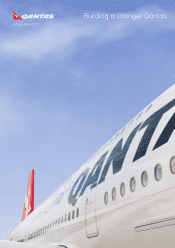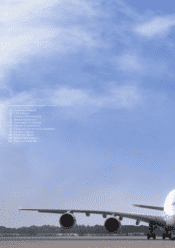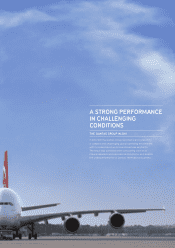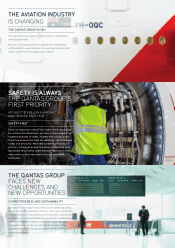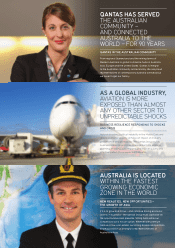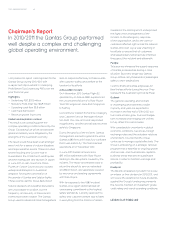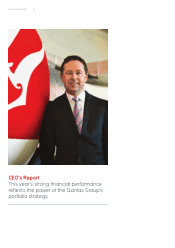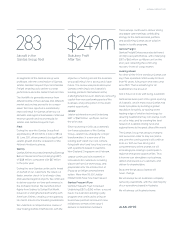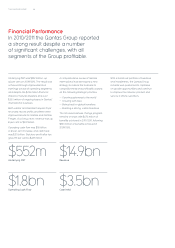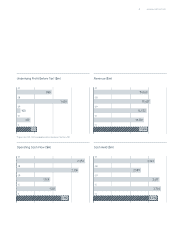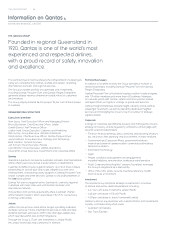Qantas 2011 Annual Report Download - page 6
Download and view the complete annual report
Please find page 6 of the 2011 Qantas annual report below. You can navigate through the pages in the report by either clicking on the pages listed below, or by using the keyword search tool below to find specific information within the annual report.
THE QANTAS GROUP 4
I am pleased to report a strong result for the
Qantas Group during 2010/2011, with
a 46 per cent improvement in Underlying
Prot Before Tax (Underlying PBT) over the
prior nancial year.
Highlights
— Underlying PBT: $552 million
— Statutory Prot After Tax: $249 million
— Operating cash ow: $1.8 billion
— Cash held: $3.5 billion
— Revenue growth: 8 per cent
Global and Australian context
This result is very pleasing given the
complex operating conditions faced by the
Group. Escalating fuel prices and broader
global uncertainty were mitigated by the
strengths of the Australian economy.
The result would have been even stronger
were it not for a series of natural disasters
and major weather events. These included
severe ooding and Cyclone Yasi in
Queensland, the Christchurch earthquake,
and the earthquake and tsunami in Japan.
In June 2011 an ash cloud from Chile’s
Puyehue-Cordon Caulle volcano caused
widespread disruption to Australian
airspace, forcing the cancellation of
thousands of Qantas and Jetstar ights.
These events cost the Group $224 million.
Natural disasters and weather disruptions
are unavoidable in aviation, but the
frequency and severity of these recent
events have been notable. The Qantas
Group used its advanced crisis management
skills to respond effectively to these events,
with customer safety and welfare at the
forefront of its efforts.
Airbus A380 incident
On 4 November 2010 Qantas Flight 32,
operated by an Airbus A380, experienced
the uncontained failure of a Rolls-Royce
Trent 900 engine en route from Singapore
to Sydney.
Led calmly by Captain Richard De Crespigny
and Customer Service Manager Michael
Von Reth, the crew on board responded
magnicently, and the aircraft was returned
safely to Singapore.
Due to the gravity of the incident, Qantas
management elected to ground the entire
Qantas A380 eet until it was fully condent
that it was safe to y. The eet resumed
operations on 27 November 2010.
In June 2011 Qantas announced a
$95 million settlement with Rolls-Royce
relating to the disruptions caused by the
incident. The repair and related costs to
return the aircraft to service, estimated
at US$145 million, are separately covered
by insurance and existing agreements
with Rolls-Royce.
With its response to the A380 incident,
Qantas once again demonstrated an
unwavering commitment to the highest
safety standards. A priority approach to
safety and customer welfare was evident
in everything from the millions of dollars
invested in the training which underpinned
the ight crew’s management of the
incident, to the emergency response
of the organisation, and to the care for
customers affected right across the network.
Qantas CEO Alan Joyce was unstinting in
his efforts to ensure that all customers
and stakeholders remained fully informed
throughout the incident and aftermath.
People
This year we witnessed the superb response
of Qantas professionals during a crisis
situation. But every single day Qantas
Group airlines carry thousands of passengers
safely to their destinations.
I want to thank all Qantas employees for
their tireless efforts during the year. They
represent the Australian spirit at its nest.
Outlook
The general operating environment
is challenging and extremely volatile.
Capacity and yield are expected to
increase in the rst half of 2011/2012, but
fuel costs will also grow. Fuel surcharges,
fare increases and hedging are unlikely
to fully offset this cost increase.
With considerable uncertainty in global
economic conditions, fuel prices, foreign
exchange rates and the industrial relations
environment, it is vital that the Group
continues to manage capital effectively. The
Group is embarking on a strategic renewal
program that is essential to ongoing growth
and success, and must allocate capital to
business areas that deliver sustainable
returns in order to maintain earnings and
protability.
Dividend
The Board considered it prudent not to pay
an interim or nal dividend in 2010/2011, and
will review the potential for future dividends
against the Group’s funding requirements,
the need to maintain an investment-grade
credit rating and overall operating conditions.
Chairman’s Report
In 2010/2011 the Qantas Group performed
well despite a complex and challenging
global operating environment.
LEIGH CLIFFORD AO

